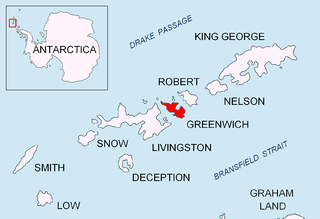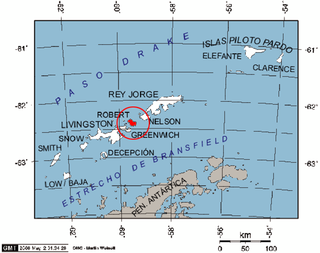
Smith Island is 20 miles (32 km) long and 5 miles wide, lying 45 miles (72 km) west of Deception Island in the South Shetland Islands of the British Antarctic Territory. Surface area 148 square kilometres (57 sq mi).

Greenwich Island is an island 24 km (15 mi) long and from 0.80 to 9.66 km wide, lying between Robert Island and Livingston Island in the South Shetland Islands. Surface area 142.7 square kilometres (55.1 sq mi). The name Greenwich Island dates back to at least 1821 and is now established in international usage.

Quito Glacier is a glacier draining the northeast slopes of Mount Plymouth and flowing northeastwards into the sea west of Canto Point in north Greenwich Island, South Shetland Islands. It was named after the capital of Ecuador, c. 1990, by the Ecuadorian Antarctic Expedition.

Express Island is a narrow craggy island, 1.23 kilometres (0.76 mi) long, lying close offshore of northwest Greenwich Island in the South Shetland Islands, Antarctica. It is situated due north of Greaves Peak, forming most of the east side of Razlog Cove. Surface area 29 hectares.

Aim Rocks is a group of rocks lying east of Cape Timblón in the middle of Morton Strait in the South Shetland Islands, Antarctica. The name, given by the United Kingdom Antarctic Place-Names Committee in 1961, is descriptive; these rocks in line are a guide for safe passage through the southern entrance of Morton Strait.

Letnitsa Glacier is a 0.9 nautical miles long glacier on Smith Island in the South Shetland Islands, Antarctica draining the southeast slopes of Imeon Range east of Organa Peak and south of Riggs Peak. It is situated southwest of Gramada Glacier and northeast of Kremena Ice Piedmont, and flows southeastward into Hisarya Cove, Osmar Strait. Bulgarian early mapping in 2009. The glacier is named after the town of Letnitsa in northern Bulgaria.

Gramada Glacier is a 1.6 nautical miles long glacier on Smith Island in the South Shetland Islands, Antarctica draining the southeast slopes of Imeon Range east of Riggs Peak, southeast of Madan Saddle and south of Neofit Peak. It is situated southwest of Armira Glacier and northeast of Letnitsa Glacier, and flows southeastward into Brashlyan Cove on Osmar Strait. Bulgarian early mapping in 2009. The glacier is named after the town of Gramada in northwestern Bulgaria.

Armira Glacier is a 1.6 nautical miles long glacier on Smith Island in the South Shetland Islands, Antarctica draining the southeast slopes of Imeon Range southeast of Slaveykov Peak and east of Neofit Peak. It is situated southwest of Dragoman Glacier and northeast of Gramada Glacier, and flows southeastward into Yarebitsa Cove on Osmar Strait. Bulgarian early mapping in 2009. The glacier is named after Armira River in southeastern Bulgaria.

Dragoman Glacier is a 1.4 nautical miles long glacier on Smith Island, South Shetland Islands draining the southeast slopes of Imeon Range southeast of Zavet Saddle and south of the summit Mount Foster. It is situated southeast of Bistra Glacier, southwest of Landreth Glacier and northeast of Armira Glacier, and flows southeastward into Ivan Asen Cove, Osmar Strait. Bulgarian early mapping in 2009. The glacier is named after the town of Dragoman in western Bulgaria.

Rupite Glacier is a 1.6 nautical miles long glacier on Smith Island, South Shetland Islands draining the southeast slopes of Imeon Range east of the summit Mount Foster and southeast of Evlogi Peak. It is situated southeast of Chuprene Glacier, southwest of Pashuk Glacier and northeast of Landreth Glacier, and flows southeastward into Osmar Strait. Bulgarian early mapping in 2008. The glacier is named after the settlement Rupite and the nearby protected area in southwestern Bulgaria.

Krivodol Glacier is a 3.8 km long glacier on Smith Island, South Shetland Islands in Antarctica draining the southeast slopes of Imeon Range northeast and east of Antim Peak, southeast of Varshets Saddle and south of Slatina Peak. It is situated southwest of Ovech Glacier and northeast of Pashuk Glacier, and flows southeastward into Osmar Strait northeast od Sredets Point. Bulgarian early mapping in 2008. The glacier is named after the town of Krivodol in northwestern Bulgaria.

Ovech Glacier is a 3.5 km long glacier on Smith Island, South Shetland Islands draining the southeast slopes of Imeon Range southeast of Drinov Peak and east of Popovo Saddle and Sevlievski Peak. It is situated southeast of Vetrino Glacier and Yablanitsa Glacier, and northeast of Krivodol Glacier, and flows east-southeastward into Nikolov Cove on Boyd Strait. Bulgarian early mapping in 2009. The glacier is named after the medieval fortress of Ovech in northeastern Bulgaria.

Saparevo Glacier is a 1.8 km long and 2 km wide glacier draining the northwest slopes of Imeon Range on Smith Island, South Shetland Islands, Antarctica. It is situated northeast of Kongur Glacier, and flows north-northeast of Mount Christi and southwest of Matochina Peak into Vedena Cove in Drake Passage. Bulgarian early mapping in 2009. The glacier is named after the settlement of Saparevo in Southwestern Bulgaria.

Kongur Glacier is a 1.4 nautical miles long glacier draining the northwest slopes of Imeon Range on Smith Island in the South Shetland Islands, Antarctica. It is situated northeast of Dalgopol Glacier and southwest of Saparevo Glacier, and flows west of Mount Christi into Drake Passage. Bulgarian early mapping in 2009. The glacier is named after the peak and nature reserve of Kongur on Belasitsa Mountain in southwestern Bulgaria.

Dalgopol Glacier is a 1.8 nautical miles long glacier draining the northwest slopes of Imeon Range on Smith Island in the South Shetland Islands, Antarctica. It is situated northeast of Vetrino Glacier and southwest of Kongur Glacier, and flows north of Mount Pisgah and northwest of Mezek Peak into Drake Passage. Bulgarian early mapping in 2009. The glacier is named after the town of Dalgopol in northeastern Bulgaria.

Yablanitsa Glacier is a 1.8 km long glacier on Smith Island in the South Shetland Islands, Antarctica. It is situated north-northeast of Chuprene Glacier, southwest of Vetrino Glacier and northwest of Ovech Glacier, and flows west of Drinov Peak into Cabut Cove. The feature is named after the town of Yablanitsa in northern Bulgaria.

Macy Glacier is a 3.7 nautical miles long and 1.4 nautical miles crescent-shaped glacier on the southern slopes of the Tangra Mountains, Livingston Island in the South Shetland Islands, Antarctica. The glacier is bounded by Friesland Ridge to the northwest, Levski Ridge to the northeast and Peshev Ridge to the southeast, and flows southwestwards into the head of Brunow Bay.

Cecilia Island is the ice-free southernmost island of the Aitcho group on the west side of English Strait in the South Shetland Islands, Antarctica. Extending 910 by 450 m, surface area 36 hectares. The area, visited by American and English sealers in the early 19th century, nowadays has become a popular tourist site frequented by Antarctic cruise ships.
















